Erythromycin is a widely used macrolide antibiotic that can be a game changer for your cat’s health.
It effectively treats various bacterial infections, including respiratory and skin issues, making it a vital tool in veterinary medicine.
Understanding how to properly administer this medication and what to expect can significantly impact your cat’s recovery and well-being.
If your feline friend is facing an infection, knowing the ins and outs of erythromycin is essential.
You’ll learn not just about its efficacy, but also about the potential side effects that may arise.
As you read further, you will discover practical tips for administering it safely, ensuring your cat receives the best care without unnecessary stress.
Being informed empowers you to make better decisions for your cat’s health.
Whether it’s what to watch out for during treatment or how erythromycin compares to other antibiotics, this guide will help you navigate the complexities of feline health care.
Key Takeaways
- Erythromycin is effective for treating bacterial infections in cats.
- Understanding proper administration and side effects ensures safe treatment.
- Knowledge of alternatives and comparisons with other antibiotics is crucial for informed decisions.
Understanding Erythromycin
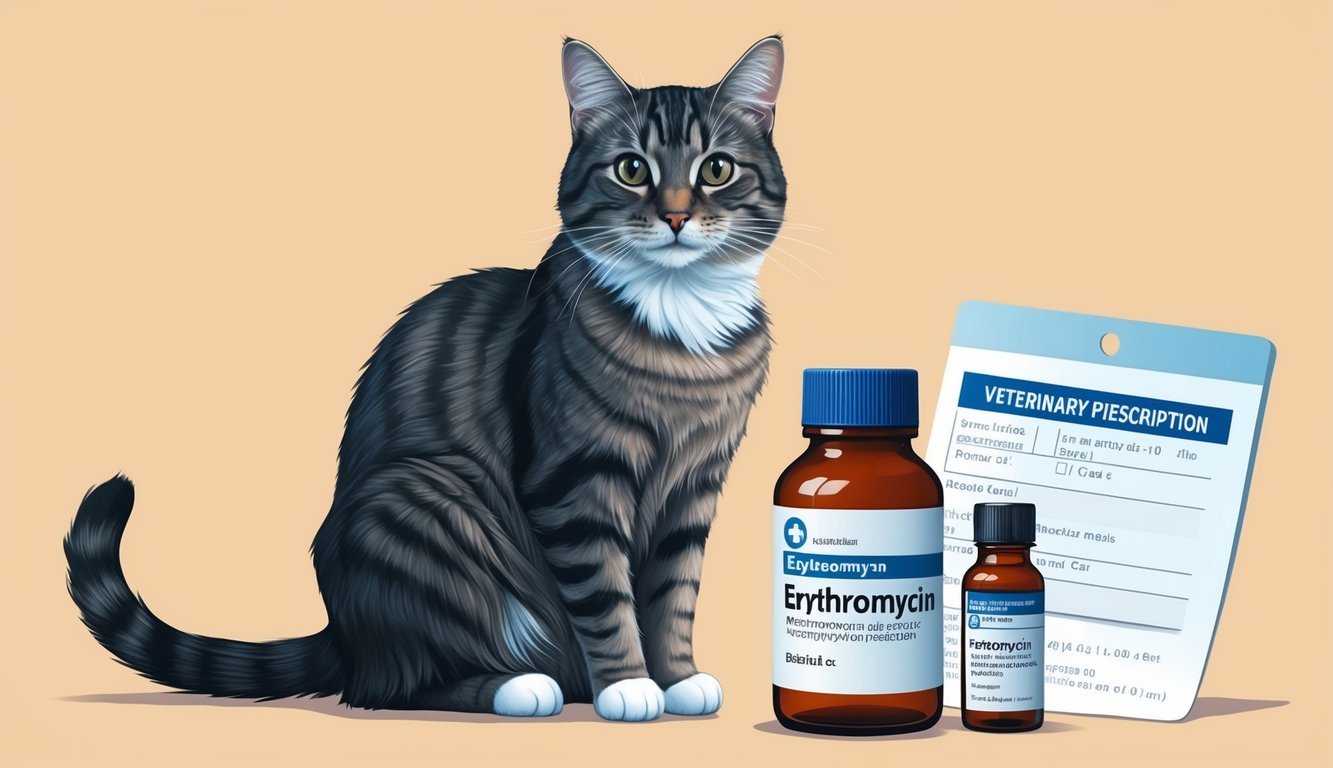
Erythromycin is an important medication in veterinary care, particularly for cats.
This section explores what erythromycin is, its role as a macrolide antibiotic, and its specific uses in veterinary medicine.
What Is Erythromycin?
Erythromycin is an antibiotic belonging to the macrolide class.
It is effective against a range of bacteria, especially Gram-positive ones.
You may find it useful for treating certain bacterial infections in cats.
This medication works by inhibiting bacterial protein synthesis, which effectively stops the growth of harmful bacteria.
It’s essential to administer the correct dosage, as adverse effects can occur.
Therefore, consultation with your veterinarian is crucial before starting treatment.
The Role of Erythromycin as a Macrolide Antibiotic
As a macrolide antibiotic, erythromycin plays a vital role in fighting infections.
Macrolides are known for their ability to target specific bacteria without affecting many others.
This selective action makes them valuable in treating conditions that do not respond well to other antibiotics.
Erythromycin is particularly indicated in cases of respiratory infections, skin infections, and certain gastrointestinal issues.
It is often chosen for its efficacy against bacteria resistant to other antibiotics.
Keep in mind that it is not a broad-spectrum antibiotic, so its use is specific based on the infection type.
Erythromycin in Veterinary Medicine
In veterinary medicine, erythromycin is prescribed for various feline ailments.
It may be utilized to treat conditions like pneumonia, conjunctivitis, and skin infections.
Despite its effectiveness, erythromycin is rarely given orally due to its limited spectrum against certain bacteria.
It’s mainly used in situations where other antibiotics are ineffective or inappropriate.
Be cautious if your cat has a known allergy or any liver or kidney issues, as these conditions can complicate treatment.
Always follow your veterinarian’s guidance when administering this medication.
Erythromycin’s Uses in Cats
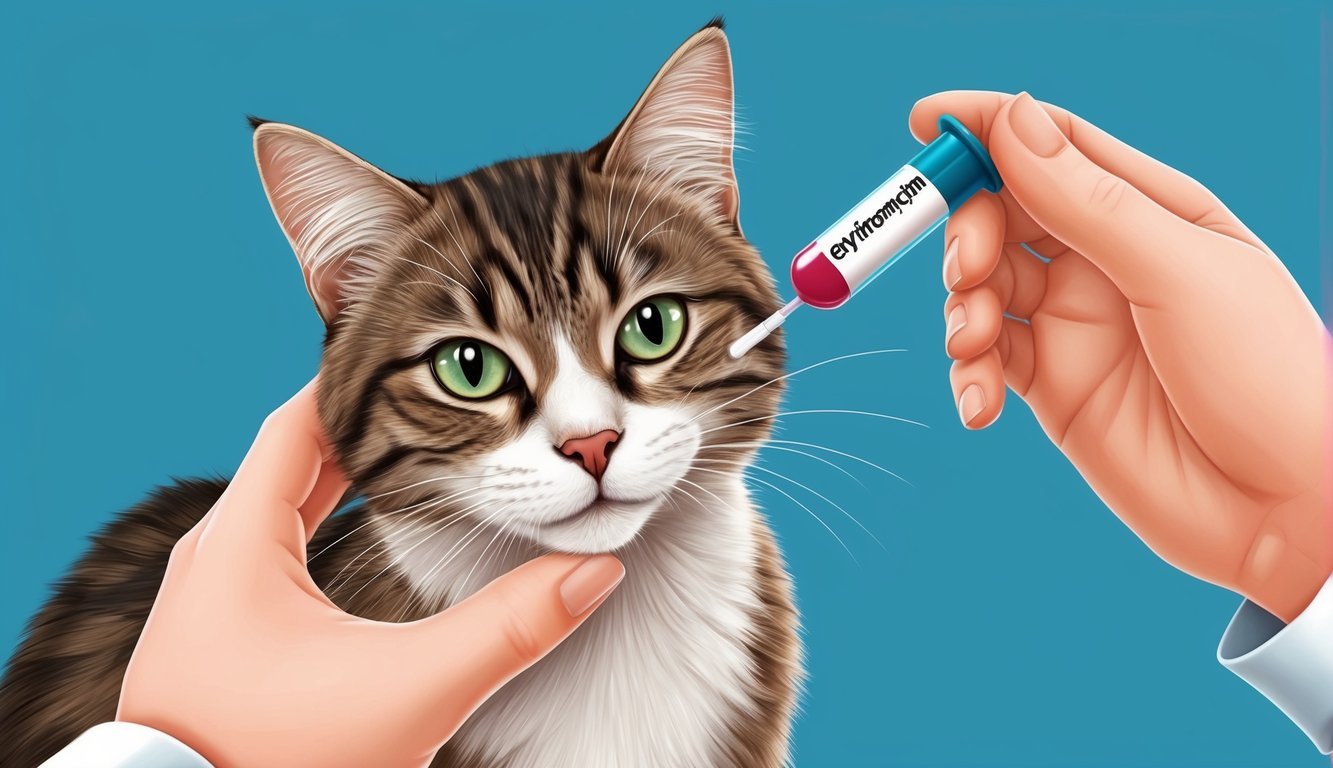
Erythromycin is an important antibiotic in feline medicine, especially when dealing with specific bacterial infections.
Its effectiveness covers a range of common issues, from skin infections to respiratory tract concerns.
Treating Common Bacterial Infections
Erythromycin is often prescribed to combat various bacterial infections in cats.
This includes infections caused by bacteria like Escherichia coli and Staphylococcus species.
Not all bacterial infections will respond to erythromycin due to potential resistance.
Veterinarians consider the type of bacteria and susceptibility before recommending this medication.
Signs that may indicate a bacterial infection include fever, lethargy, and unusual discharge.
If your cat displays these symptoms, seeking veterinary advice promptly is crucial.
Role in Skin and Wound Infections
When it comes to skin issues, erythromycin can be beneficial in treating abscesses and skin infections.
These types of infections often arise from bites, scratches, or other injuries.
Erythromycin works by inhibiting bacterial growth, helping the body to heal more effectively.
Your veterinarian might recommend this medication, especially if your cat has persistent skin issues that haven’t responded to other treatments.
It’s essential to monitor your cat during treatment.
Watch for any side effects like vomiting or diarrhea, which can occur in some animals.
Respiratory and Urinary Tract Infections
Erythromycin is also useful in treating respiratory infections that can affect cats.
Common symptoms include sneezing, nasal discharge, and coughing.
For urinary tract infections, erythromycin is less frequently used, but it can be effective in some cases.
It helps clear infections that cause harmful bacteria in the urinary system.
Regular check-ups and follow-ups with your vet ensure effective management of these conditions and allow for adjustments in treatment if necessary.
Dealing with Gastrointestinal Infections
In certain situations, erythromycin can be used to treat gastrointestinal infections.
These infections often lead to symptoms like vomiting, diarrhea, and loss of appetite.
Erythromycin aids in promoting gastrointestinal motility, meaning it can help food move through the digestive system more effectively.
However, this use is generally off-label, so it’s crucial to have a veterinarian’s guidance.
Close observation during this treatment is vital for your cat’s well-being.
How to Administer Erythromycin
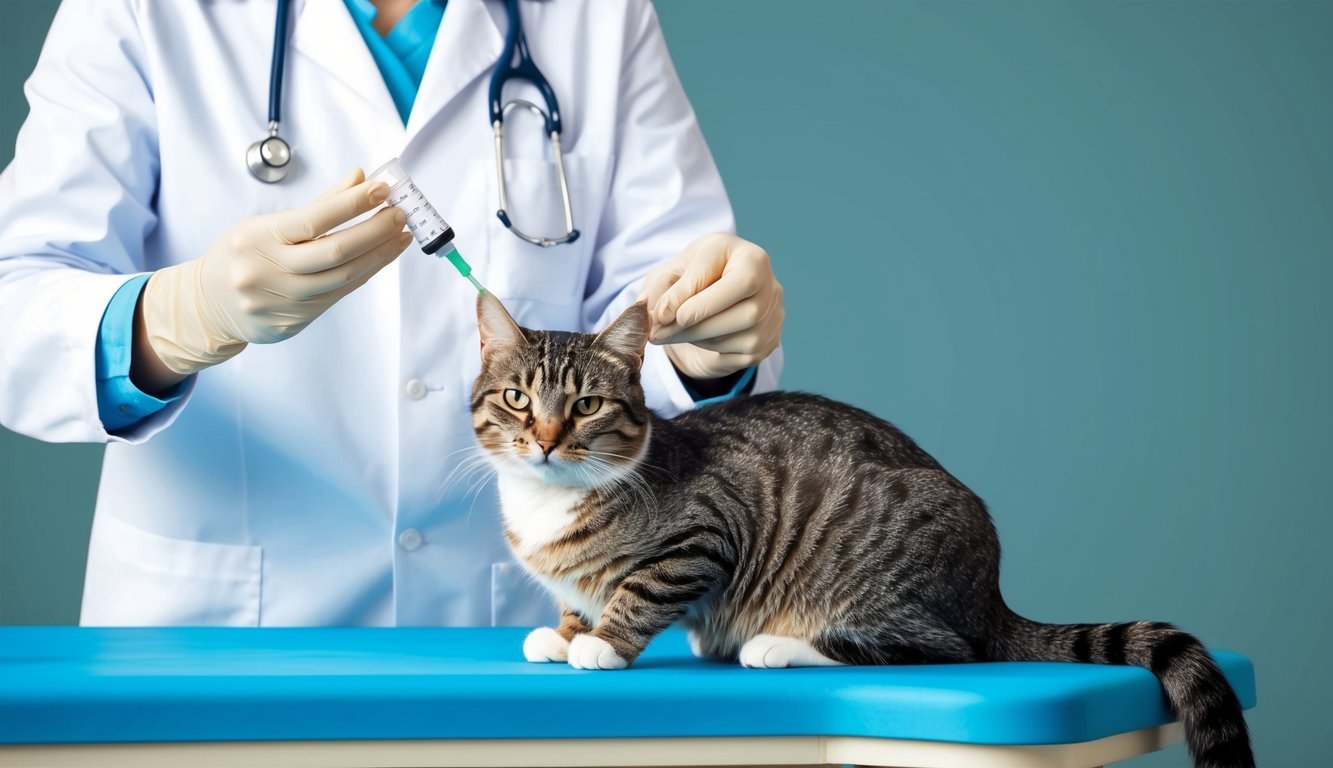
Administering erythromycin to your cat requires attention to the form of the medication, correct dosage, and effective techniques for administration.
These elements are crucial for ensuring your cat receives the medication safely and effectively.
Forms of Erythromycin Available
Erythromycin comes primarily in two forms: oral tablets and oral suspension.
The tablet form is often prescribed for easier dosing, while the oral suspension can be easier for pets that are picky or resistant to swallowing pills.
When choosing a form, consider what your cat prefers.
For instance, if your cat tends to spit out pills, an oral suspension may be the best option.
Always check with your veterinarian to ensure you have the correct form prescribed for your cat’s condition.
Determining the Proper Dosage
Determining the right dosage of erythromycin is essential for its effectiveness and safety.
The typical dosage for cats ranges from 5 to 10 mg per pound (or 10 to 20 mg per kilogram) of body weight, given every 8 to 12 hours.
Your vet will assess your cat’s health condition and weight to determine the exact dosage.
It’s important not to adjust the dose without consulting your veterinarian, as improper dosing can lead to resistance or adverse reactions.
Techniques for Effective Administration
Administering erythromycin effectively can make a big difference.
If you’re using tablets, you can try hiding them in a small amount of your cat’s favorite food.
This often makes it easier for them to take the medication without realizing.
For oral suspension, a syringe (without a needle) can help.
Gently squirt the liquid toward the back of your cat’s mouth to ensure they swallow it.
Always follow these tips for a smoother administration process:
- Stay calm: Your cat can sense your nervousness.
- Be gentle: Don’t force your cat; instead, be patient.
- Offer a reward: Follow up with a treat or extra petting to make it a positive experience.
Using these techniques will help ensure your cat receives the full benefit of the medication.
Potential Side Effects and Interactions
When considering erythromycin for your cat, it’s crucial to recognize potential side effects and interactions with other medications.
This information helps ensure your cat’s safety while on treatment.
Recognizing Side Effects in Cats
Erythromycin may cause side effects in your cat, and being aware of these is essential.
Common side effects include vomiting, diarrhea, and loss of appetite.
If your cat experiences nausea or decreased appetite, it’s important to monitor them closely.
You might notice changes in behavior or energy levels as well.
If these symptoms appear mild, they may resolve on their own, but persistent or worsening signs should lead to a consultation with your veterinarian.
Always inform your vet about any side effects your cat shows while on erythromycin.
Allergic Reactions and Their Signs
In rare cases, your cat may experience an allergic reaction to erythromycin.
Signs of an allergic reaction can include hives, swelling of the face or paws, and difficulty breathing.
If you notice these symptoms, seek veterinary help immediately.
Other signs may include excessive itching or lethargy.
It’s crucial to act quickly, as allergic reactions can escalate rapidly.
Always inform your vet if your cat has a history of drug allergies, helping to prevent potential reactions during treatment.
Important Drug Interactions to Consider
Erythromycin can interact with several medications, so it’s essential to inform your vet about all medications your cat is taking.
For example, it can affect the effectiveness of cisapride and theophylline.
Additionally, combining erythromycin with prednisolone or methylprednisolone may increase the risk of side effects.
These interactions can lead to complications, including elevated toxicity or reduced effectiveness of treatment.
Your veterinarian can help you navigate these interactions, ensuring the best outcome for your cat.
Monitoring and Safety Measures
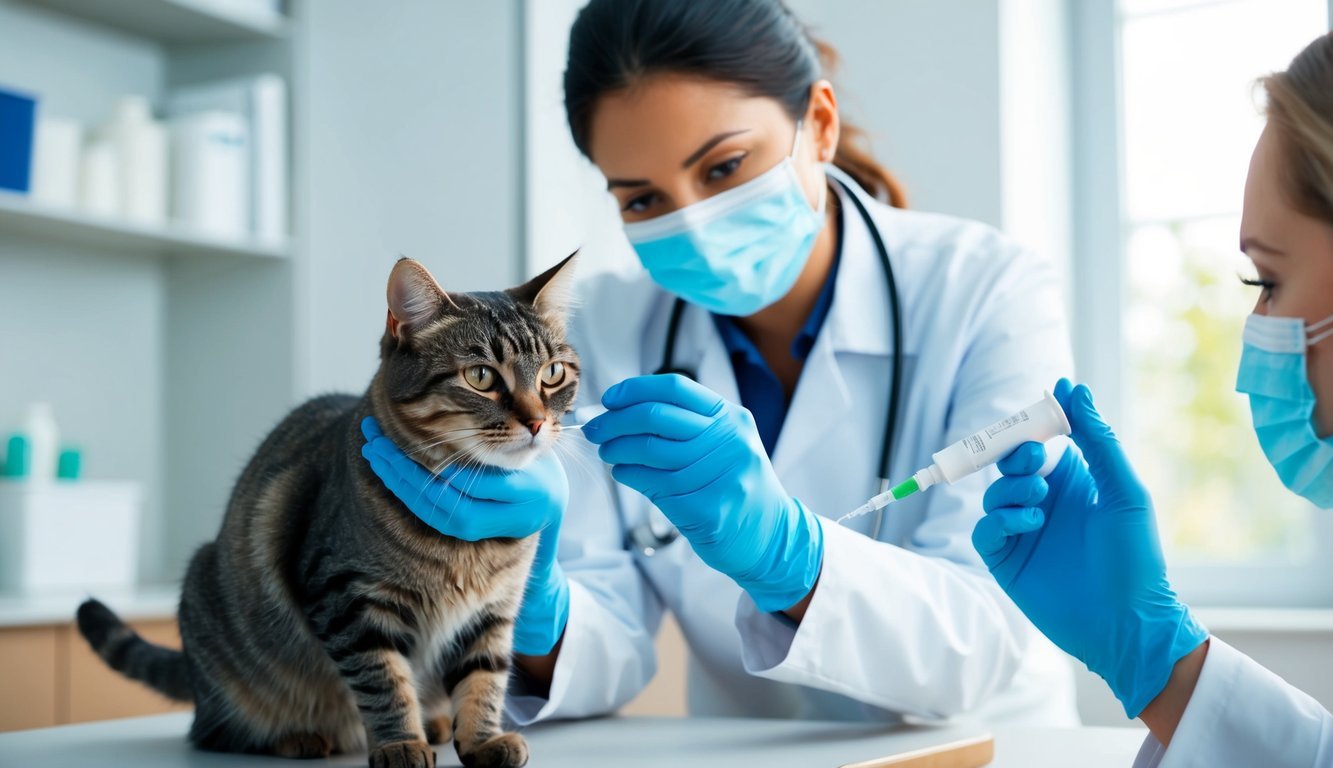
When your cat is prescribed erythromycin, keeping a close watch on their health is essential.
This involves regular veterinary check-ups, attentive management of their treatment, especially for chronic conditions, and being cautious if they have liver or kidney issues.
Regular Check-Ups with Your Veterinarian
Regular check-ups are crucial for monitoring your cat’s reaction to erythromycin.
Schedule visits every few weeks, especially during the initial treatment phase.
Your veterinarian can assess any side effects, such as gastrointestinal upset, which may include vomiting or diarrhea.
Your vet will also check for signs of allergic reactions, which—though rare—can occur.
Keeping a record of your cat’s symptoms can help your veterinarian make informed decisions.
Managing Erythromycin Treatment for Chronic Conditions
If your cat has chronic conditions requiring long-term erythromycin use, ongoing management becomes vital.
Discuss potential side effects with your veterinarian.
They might suggest periodic blood tests to monitor organ function, especially the liver.
Establish a medication schedule that fits your cat’s routine.
Consistency in giving medication helps maintain effective treatment levels in their system.
Always report any new symptoms, as they may indicate a need for dosage adjustments or a change in treatment.
Erythromycin Use in Cats with Liver and Kidney Disease
If your cat suffers from liver or kidney disease, erythromycin use requires extra care.
The liver plays a significant role in metabolizing medications, so impaired liver function can alter how well erythromycin works and how safely it can be administered.
Your veterinarian may recommend starting with a lower dose and may adjust it based on liver function tests.
Additionally, observe your cat closely for any signs of liver distress, such as lethargy, jaundice, or unusual behavior.
Continuous communication with your vet is key to ensuring your cat’s safety and effectiveness of the treatment.
Comparing Erythromycin with Other Antibiotics

When considering treatment options for your cat, it’s essential to compare erythromycin with other common antibiotics.
Each antibiotic has its strengths and weaknesses based on the type of infection being treated.
Erythromycin vs. Amoxicillin and Doxycycline
Erythromycin is a macrolide antibiotic often used for respiratory infections and certain bacterial conditions.
It works well against gram-positive bacteria but may have limitations in effectiveness against some gram-negative organisms.
In contrast, amoxicillin is a penicillin-type antibiotic that is often prescribed for more general infections, such as wound or urinary tract infections.
It tends to have a broader spectrum of activity, making it effective for various bacterial threats.
Doxycycline, a tetracycline antibiotic, is often your go-to for tick-borne infections like Lyme disease.
It’s also useful for sinus and respiratory infections.
Choosing between these antibiotics depends on the specific type of infection your cat has and any potential side effects.
Alternative Treatments for Specific Infections
For certain infections, alternative antibiotics like azithromycin or gallimycin could be better options.
Azithromycin, a semi-synthetic macrolide, has a broader spectrum of activity than erythromycin and is easier to administer due to its once-daily dosing.
If your cat is dealing with chronic conditions like pneumonia or severe bacterial infections, you might want to explore options like doxycycline or amoxicillin.
Each treatment has its unique characteristics, so it’s crucial to consult with your veterinarian for tailored advice.
Using the right antibiotic can make a difference in recovery times and effectiveness, so understanding these options will help you make informed decisions for your cat’s health.
Conclusion
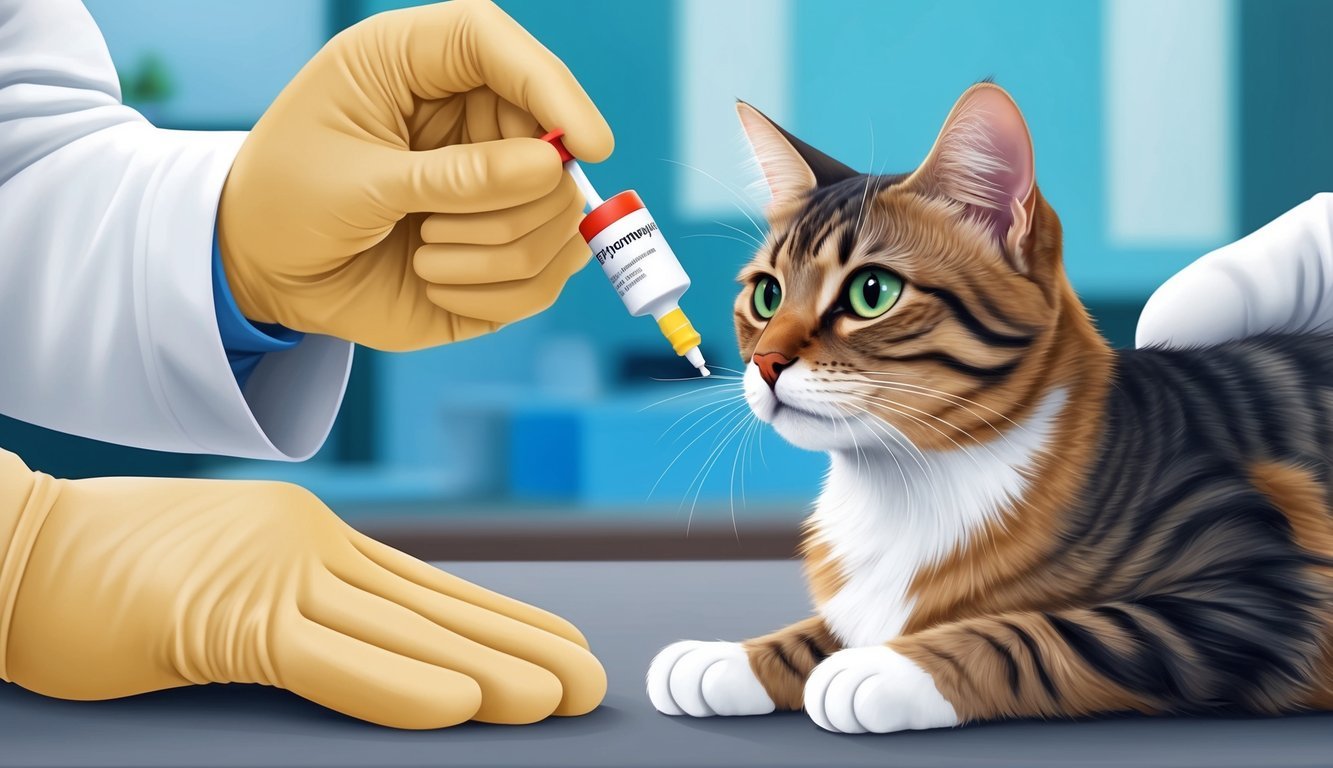
Erythromycin can be a useful antibiotic option for your cat when prescribed by a veterinarian.
It’s effective in treating various infections, including skin and respiratory issues.
Safety is key. Always consult your vet before starting any medication.
Some cats may experience side effects, and your vet will help determine the best course of action.
It’s important to monitor your cat closely while on erythromycin.
If you notice any unusual behavior or reactions, contact your veterinarian immediately.
Remember: Administer the medication as directed.
Following the proper dosage helps ensure effective treatment and minimizes the risk of antibiotic resistance.
Ultimately, working closely with your vet ensures your cat receives the best care possible.
It’s your responsibility to understand the treatment and contribute to your cat’s health.
Frequently Asked Questions
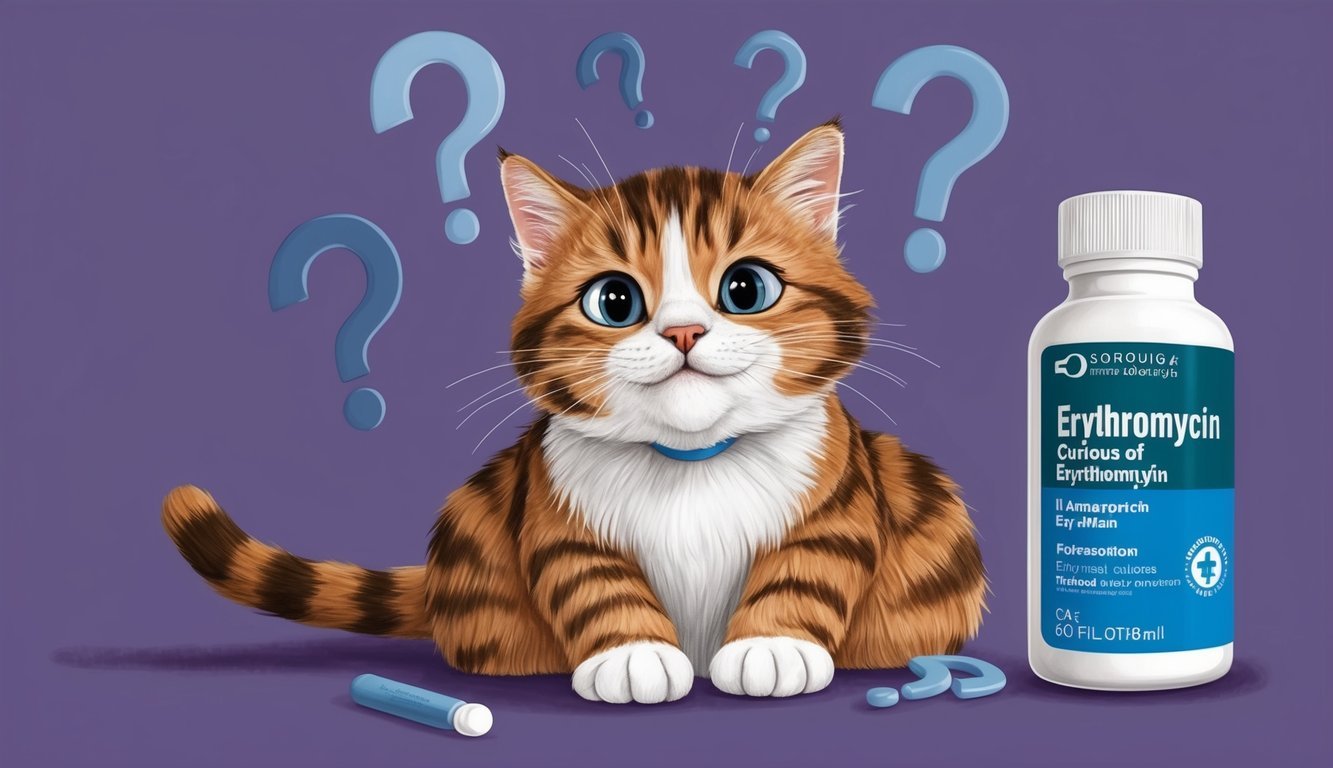
When considering erythromycin for your cat, several important questions often arise.
Understanding dosages, potential side effects, and treatment specifics can help you make informed decisions for your feline friend.
How should erythromycin be dosed for cats?
The dosage of erythromycin for cats generally depends on their weight and the condition being treated.
A common guideline is about 5 to 10 mg per kilogram of body weight, administered two to three times a day.
Always consult your veterinarian for precise dosing tailored to your cat’s needs.
What side effects might cats experience when taking erythromycin?
While erythromycin is considered safe, some cats might experience side effects.
These can include gastrointestinal upset such as vomiting or diarrhea, and in rare cases, allergic reactions may occur.
If you notice unusual behavior or symptoms, contact your veterinarian immediately.
For how many days should I administer erythromycin to my cat?
The duration of treatment with erythromycin can vary.
Typically, your vet may recommend administering it for 7 to 14 days, depending on the infection’s severity.
It’s vital to complete the full course, even if your cat appears better before finishing the medication.
Is it safe to use erythromycin ointment in my cat’s eyes?
Yes, erythromycin ophthalmic ointment is commonly used to treat eye infections in cats.
It works specifically to eliminate bacterial growth in the affected eye.
Ensure you follow your veterinarian’s instructions for application to avoid complications.
How does the weight of my cat influence the dosage of erythromycin?
The weight of your cat plays a crucial role in determining the appropriate dosage of erythromycin.
Heavier cats may require higher doses, while lighter cats will need less.
Accurate dosing based on weight helps ensure the medication is effective without being harmful.
What types of infections in cats can erythromycin treat?
Erythromycin can treat various infections in cats.
These include skin infections, respiratory infections, and certain types of gastrointestinal conditions.
Your veterinarian can help determine if erythromycin is the right choice based on the specific infection affecting your cat.

